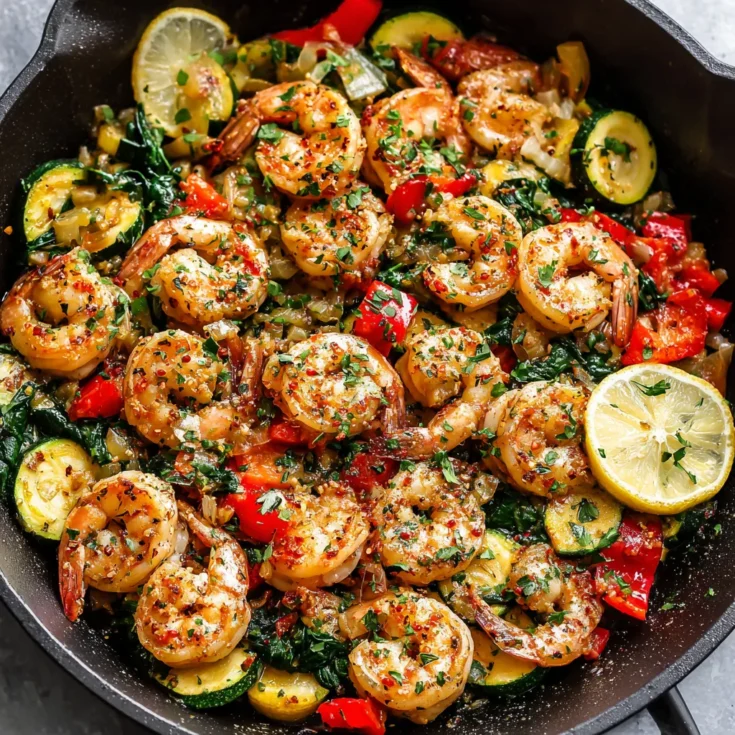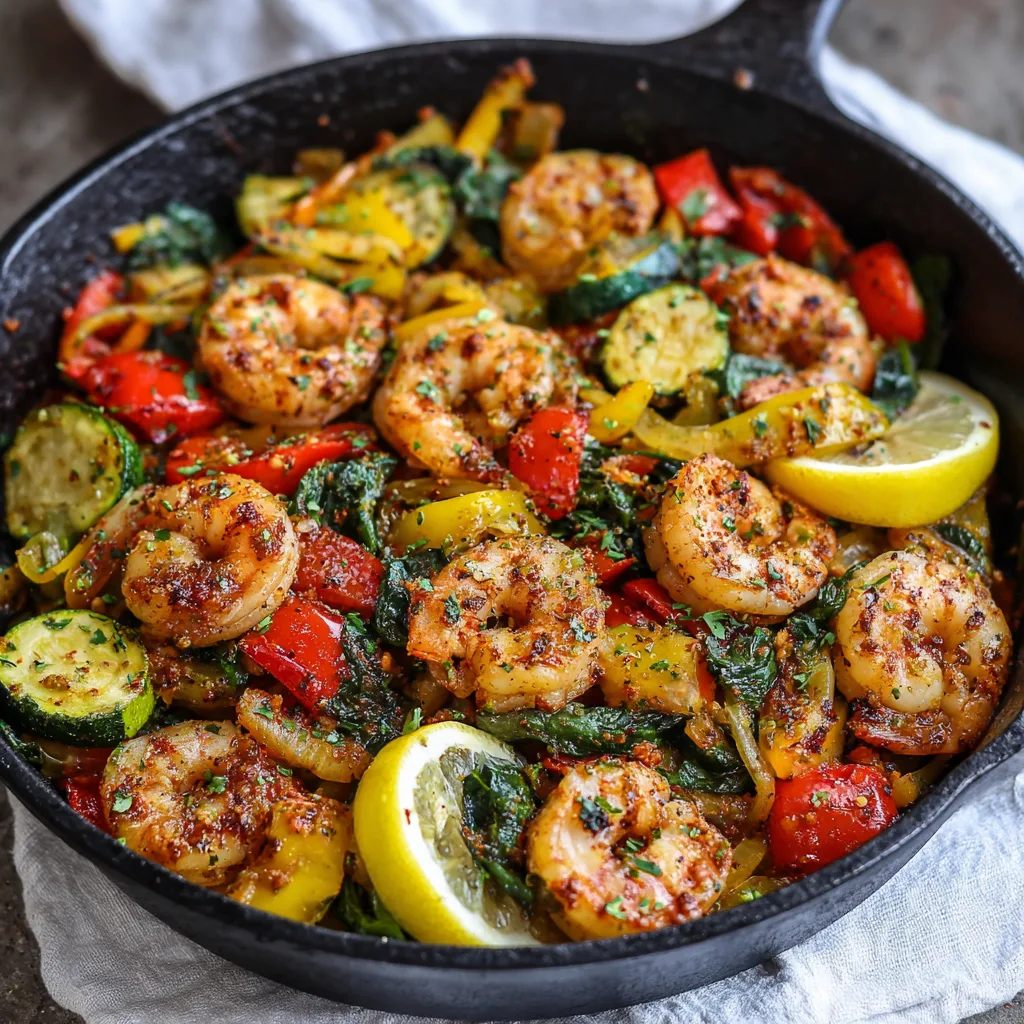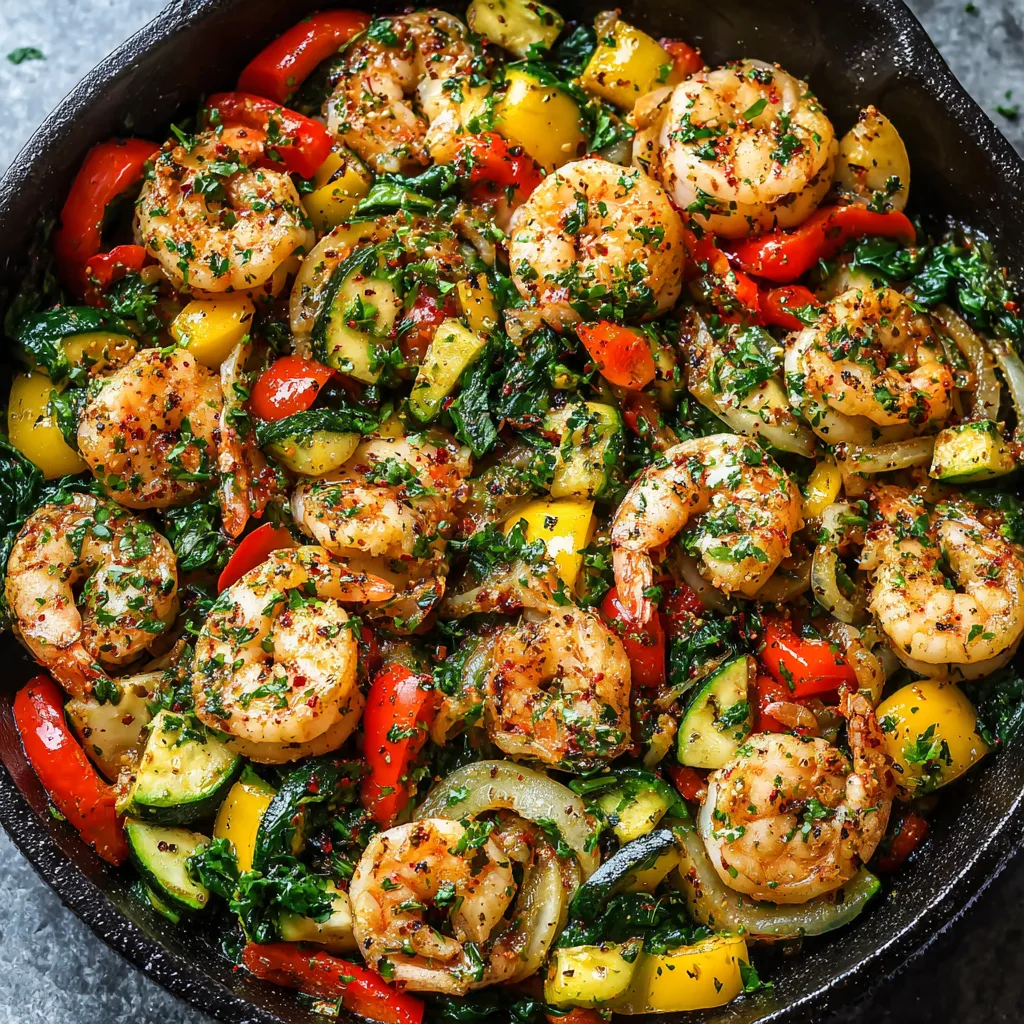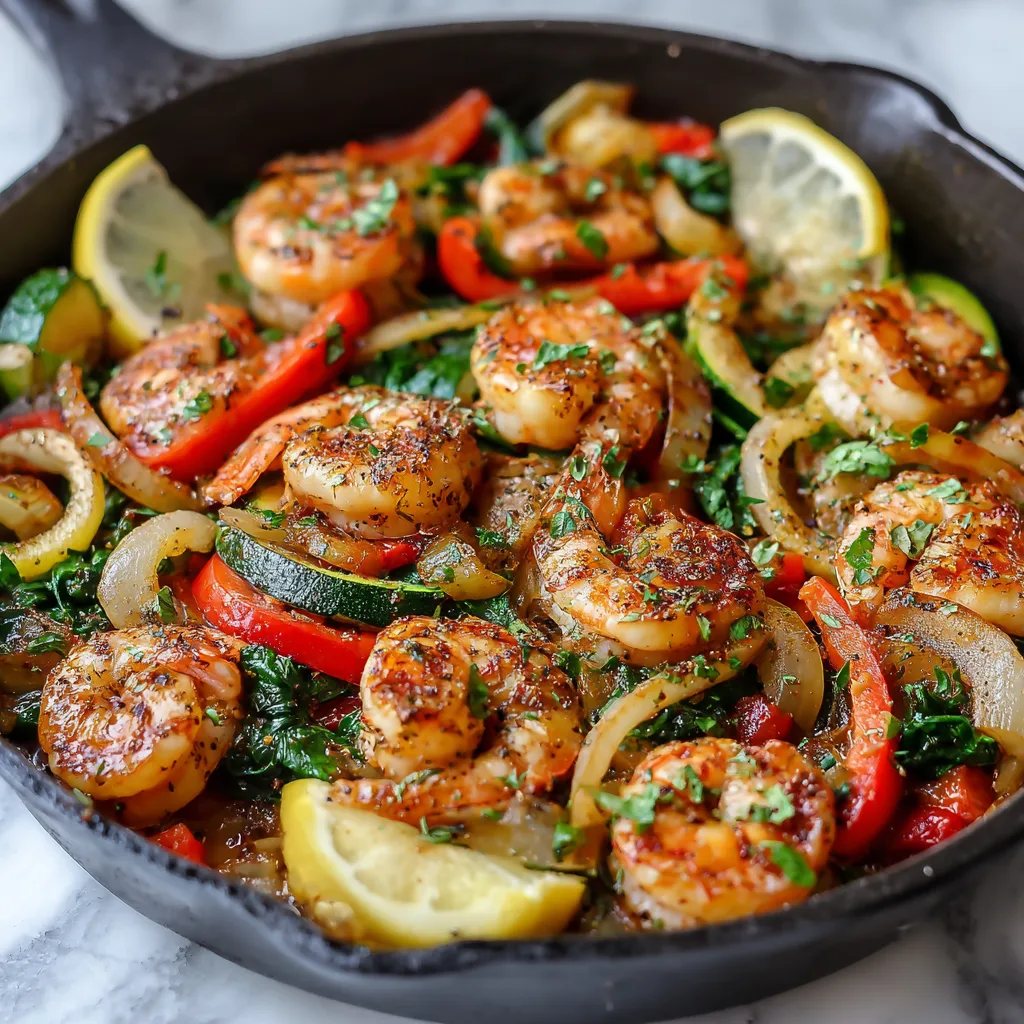What Is a High Protein Low Carb Shrimp Skillet?
A high protein low carb shrimp skillet is a quick, flavorful dish designed to fuel your body while keeping carbohydrates low. It combines tender shrimp with nutrient-packed vegetables, cooked together in a single pan. This approach maximizes taste and nutrition, making it ideal for busy days or healthy meal prep. The skillet method keeps cooking simple, reduces cleanup, and ensures each bite bursts with bold flavors.
In today’s health-conscious world, many people seek meals that balance protein and carbs efficiently. This shrimp skillet fits perfectly into such diets by offering a satisfying option without excess sugars or starches. It supports those who want to maintain energy levels, lose weight, or simply eat cleaner. Its convenience and wholesome ingredients make it a staple in many modern kitchens.
Why Choose Shrimp for This Skillet?
Shrimp stands out as a top choice for a high protein low carb skillet for several reasons. First, shrimp packs an impressive protein punch with minimal calories. A typical 3-ounce serving delivers about 20 grams of protein, supporting muscle growth and repair efficiently.
Additionally, shrimp contains almost no carbohydrates, making it perfect for low carb diets. This lean seafood is rich in essential nutrients like selenium, vitamin B12, and iodine. These vitamins and minerals contribute to overall health, immune function, and thyroid support. Shrimp also offers a mild flavor that easily absorbs spices and herbs, enhancing your skillet’s taste profile.
Health Benefits of a High Protein, Low Carb Meal
Eating a meal rich in protein but low in carbohydrates delivers several health benefits. First, it supports muscle building and repair by providing essential amino acids. This is crucial not only for athletes but for anyone wanting to maintain muscle mass and strength.
Second, low carb meals aid in weight management by reducing insulin spikes and promoting fat burning. Shrimp skillet recipes typically include healthy fats and fiber-rich vegetables, which improve satiety and reduce overeating. Finally, these meals help stabilize blood sugar levels, reducing energy crashes and cravings. This balance supports sustained focus and wellbeing throughout the day.
Macronutrient Composition of a High Protein Low Carb Shrimp Skillet
Understanding the macronutrient profile is key when choosing a high protein low carb shrimp skillet. Each serving typically offers around 20 to 25 grams of protein, making shrimp an excellent source to meet your daily protein needs. The protein fuels muscle repair, supports metabolism, and keeps you feeling full longer.
Carbohydrates remain minimal in this dish, usually under 10 grams per serving. The low carb count primarily comes from the fresh vegetables paired with shrimp. Healthy fats, sourced from cooking oils like olive or avocado oil, range from 8 to 12 grams per serving. These fats provide energy and aid in absorbing fat-soluble vitamins. Compared to other protein sources such as chicken or beef, shrimp delivers similar protein with fewer calories and almost zero carbs, which makes it ideal for carb-conscious diets.
Micronutrients in Shrimp: Vitamins and Minerals
Shrimp shines not just in protein but also as a rich source of essential micronutrients. It contains significant amounts of selenium, a powerful antioxidant that helps protect cells from damage. Additionally, shrimp provides vitamin B12, which supports nerve health and red blood cell production.
Other minerals like iodine promote healthy thyroid function, while zinc boosts immune defense. Shrimp also contains small amounts of vitamin D and iron, further enhancing its nutritional value. These nutrients work together to support overall wellness, making the shrimp skillet a nutrient-dense meal option. Its antioxidant properties also help reduce inflammation and support cardiovascular health.
Health Considerations: Heart Health and Dietary Suitability
The high protein low carb shrimp skillet aligns well with heart-healthy eating patterns. Shrimp contains omega-3 fatty acids, which help reduce inflammation and improve cholesterol levels. Using healthy fats such as olive oil further supports cardiovascular benefits by promoting good HDL cholesterol.
This dish fits perfectly into various dietary lifestyles including keto, paleo, and gluten-free plans. Its flexibility allows easy adaptation for different preferences by swapping vegetables or spices. However, it’s important to note that shrimp is a common allergen. Individuals with shellfish allergies should avoid this meal or use alternative proteins like chicken or tofu. Proper cooking and sourcing fresh shrimp also ensure safety and quality.
Essential Ingredients for a High Protein Low Carb Shrimp Skillet
Choosing the right ingredients sets the foundation for a delicious and nutritious shrimp skillet. Start with fresh or frozen shrimp, which offer versatility and convenience. When selecting shrimp, opt for large, peeled, and deveined varieties to simplify preparation. If using frozen shrimp, thaw them properly in cold water to preserve texture and flavor.
Low-carb vegetables add both color and nutrition to the skillet. Popular choices include zucchini, bell peppers, and spinach. These vegetables contribute fiber and vitamins while keeping carbohydrate counts low. They also provide natural sweetness and crunch that complement shrimp perfectly.
Healthy fats are essential for cooking and flavor. Olive oil and avocado oil are excellent options due to their stability at medium-high heat and heart-healthy properties. For a richer taste, a small amount of butter can add creamy depth. These fats help absorb fat-soluble vitamins and improve satiety.
Seasonings and herbs bring the dish to life. Garlic adds aromatic warmth, while fresh lemon juice and zest offer bright acidity. Parsley imparts a fresh, earthy note, and chili flakes provide a subtle kick for spice lovers. These simple ingredients elevate the overall flavor profile without adding carbs.
Cooking Techniques for the Perfect Shrimp Skillet
Mastering the right cooking techniques ensures shrimp stay tender and vegetables retain their crunch. Sautéing shrimp in a skillet with oil allows quick, even cooking and helps seal in juices. Alternatively, grilling shrimp can add smoky char and enhance flavor but requires careful attention to avoid overcooking.
Avoiding overcooking shrimp is critical. Cook shrimp just until they turn pink and opaque, which usually takes 3 to 4 minutes per side. Overcooked shrimp become tough and rubbery, detracting from the dish’s enjoyment.
Incorporating vegetables correctly builds texture and flavor complexity. Start by sautéing low-carb veggies like zucchini and bell peppers until they soften but still retain slight crispness. Add spinach last since it wilts quickly. This layering approach balances tenderness with bite, creating a satisfying mouthfeel.
Flavor Enhancements to Elevate Your Shrimp Skillet
Spices and herbs dramatically boost the dish’s appeal. Experiment with smoked paprika, cumin, or Italian seasoning to deepen the flavor profile. Adding fresh garlic and chili flakes introduces warmth and subtle heat, making the skillet more dynamic.
Balancing acidity and sweetness is key for a well-rounded taste. Lemon juice brightens the dish and cuts through richness, while a touch of natural sweetness from bell peppers or a drizzle of honey balances flavors without adding significant carbs.
Optional additions offer creative twists. Grated Parmesan cheese adds a savory, creamy element, perfect for those who enjoy richer meals. Toasted nuts or seeds such as pine nuts or sliced almonds introduce crunch and healthy fats, enhancing texture and nutritional value. These enhancements let you customize the shrimp skillet to suit your preferences while keeping it low carb and high protein.
Recipe Variations: Creative Takes on High Protein Low Carb Shrimp Skillet
Exploring recipe variations keeps your shrimp skillet exciting and caters to different taste preferences. One popular twist is the Spicy Cajun Shrimp Skillet. This version uses bold Cajun spices like paprika, cayenne, garlic powder, and thyme to deliver a fiery kick. It pairs perfectly with creamy avocado or a simple cucumber salad to balance heat with freshness.
For a richer option, try the Creamy Garlic Parmesan Shrimp Skillet. Here, garlic and Parmesan cheese melt into a luscious sauce, coating the shrimp and vegetables. Heavy cream or coconut cream adds silkiness without increasing carbs drastically. This variation suits those craving indulgence while staying on track with low carb goals.
The Mediterranean-Inspired Shrimp Skillet brings bright, vibrant flavors to the table. Incorporate olives, sun-dried tomatoes, and crumbled feta cheese for a taste reminiscent of coastal cuisine. Fresh herbs like oregano and basil enhance the dish’s aromatic profile. This version pairs well with a drizzle of olive oil and a squeeze of lemon, offering a refreshing finish.
Meal Pairings: Complementing Your Shrimp Skillet
Pairing your shrimp skillet with the right sides rounds out your meal and keeps it balanced. Low-carb sides like cauliflower rice offer a fluffy, rice-like texture without the carbs of traditional grains. Sautéed greens such as kale, Swiss chard, or spinach add earthy flavors and extra nutrients, enhancing the skillet’s overall nutrition.
Complementary salads bring freshness and crunch. A simple arugula salad tossed with lemon vinaigrette provides peppery notes and bright acidity, perfectly offsetting the richness of the shrimp skillet. You can also add sliced cucumbers or cherry tomatoes for color and juiciness.
Beverage pairings should be light and refreshing. Herbal teas like peppermint or chamomile soothe the palate, while sparkling water infused with citrus or cucumber adds a bubbly, crisp touch. These drink options keep the meal hydrating and flavorful without adding sugars or calories. Together, these pairings elevate your shrimp skillet into a satisfying and wholesome dining experience.
Common Inquiries About High Protein Low Carb Shrimp Skillet
Can I Use Frozen Shrimp for This Recipe?
Yes, frozen shrimp works well if thawed correctly. To preserve texture and flavor, thaw shrimp in a bowl of cold water for about 15 to 20 minutes. Avoid leaving shrimp at room temperature, as it may promote bacterial growth. Once thawed, pat shrimp dry with paper towels to prevent excess moisture during cooking. Using frozen shrimp offers convenience without sacrificing quality, making it a great option for busy cooks.
How Can I Make the Dish Spicier?
Adding heat to your shrimp skillet is simple and customizable. Incorporate finely chopped jalapeños or serrano peppers while sautéing vegetables for fresh, natural spice. Alternatively, sprinkle cayenne pepper or red chili flakes into the skillet during cooking for a controlled, even heat. Start with small amounts and adjust to taste, ensuring the spice level suits your preference without overpowering the other flavors.
Is This Dish Suitable for Meal Prepping?
Absolutely. This shrimp skillet keeps well when stored properly in airtight containers in the refrigerator. For best quality, consume within three days. When reheating, warm the skillet gently on the stovetop over medium heat or in a microwave to avoid drying out the shrimp. Adding a splash of water or broth can help retain moisture. This meal’s quick prep and storage make it ideal for busy schedules and weekly meal plans.
Can I Substitute Shrimp with Other Proteins?
Yes, the recipe is versatile and works well with other proteins. Chicken breast or thighs offer a lean, mild alternative that pairs nicely with similar seasonings. Firm tofu can provide a plant-based option, absorbing flavors effectively when pressed and cooked properly. White fish such as cod or tilapia also works, cooking quickly and maintaining a delicate texture. Adjust cooking times according to the protein choice to ensure perfect doneness.
How Do I Adjust the Recipe for More Servings?
Scaling the recipe is straightforward. Multiply ingredient quantities proportionally based on the number of servings needed. Ensure your skillet or pan is large enough to accommodate the increased volume without overcrowding, which can affect cooking results. Cooking times may slightly increase, especially for vegetables, so monitor the skillet closely and stir occasionally. Dividing the cooking process into batches can help maintain even cooking and optimal texture.
High Protein Low Carb Shrimp Skillet – Quick, Healthy & One-Pan

A flavorful and nutritious skillet dish featuring succulent shrimp, low-carb vegetables, and aromatic herbs. Perfect for a quick and healthy meal that satisfies both your taste buds and dietary goals.
Ingredients
- 1 lb large shrimp, peeled and deveined
- 1 tablespoon olive oil
- 1 medium zucchini, sliced
- 1 bell pepper, sliced
- 2 cloves garlic, minced
- 1 teaspoon lemon zest
- 1 tablespoon fresh parsley, chopped
- Salt and pepper to taste
- Optional: ¼ cup grated Parmesan cheese
Instructions
Notes




